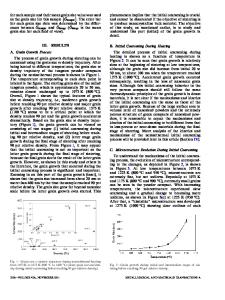In situ strength evolution during the sintering of bronze powders
- PDF / 592,279 Bytes
- 7 Pages / 612 x 792 pts (letter) Page_size
- 25 Downloads / 310 Views
INTRODUCTION
POWDER metallurgy (PM) offers unparalleled advantages in making highly detailed, net-shaped components to precise design tolerances.[1,2] One of the limitations of PM is that thermal processing can cause parts to deform or warp out of tolerance or, in the worse case, cause complete component failure through cracks.[3] Preventing these types of component defects often requires an iterative redesign to the sintering thermal cycle. To save the time and cost associated with this sort of trial-and-error design, many efforts have focused on better understanding the physical changes that occur during the sintering cycle. Once understood, the complete response of a sintering compact can be predicted, in order to make intelligent choices for thermal cycles. Yoel et al.[4,5,6] were successful in performing microscopic imaging of vacuum-debinding metal injection molded parts. They also used macroscopic gaging of 17-4 pH stainless steel during sintering to measure shrinkage. The parts were sintered to 1200 7C at a heating rate of 5 7C/min. Their observations indicated that the greatest shrinkage occurs during the heating and cooling ramps rather than at the maximum sintering temperature. Mizuno et al.[7–10] used video imaging to measure shrinkage nonuniformity during sintering of carbonyl nickel and stainless steel powder compacts. They also incorporated a digital correlation system to measure the distribution of nonuniform shrinkage in compacts sintered to temperatures up to 1300 7C. Their results indicated that most deformation occurred during the ramp to maximum temperature. These studies have made great progress describing the in situ warpage or mechanical response of a compact, but say little of what this response means in terms of sintered component failure. If the applied stress due to the in situ warpage exceeds the yield strength of the component, then the GREGORY A. SHOALES, Doctoral Candidate, and RANDALL M. GERMAN, Brush Chair Professor in Materials, are with the P/M Lab, The Pennsylvania State University, University Park, PA 16802-6809. Manuscript submitted July 18, 1997. METALLURGICAL AND MATERIALS TRANSACTIONS A
warpage, or a crack, in the case of ultimate strength, will exist in the final sintered part. Much progress has been made in modeling sintering kinetics and heat transport in sintering.[11] But we are still unable to predict the process conditions that result in warpage or cracking. Thus, adequate modeling of the in situ response must also include the evolution of the compact’s mechanical properties. The evolution of elastic modulus was indirectly investigated by Martin and Rosen.[12] In this work, they used ultrasonic velocity as a means of measuring surface area reduction during sintering of zinc oxide. Their work showed a significant increase in ultrasonic velocity prior to any change in density during the ramp to sintering temperature. Since ultrasonic velocity is proportional to elastic modulus and density,[13] this result infers the evolution of the modulus during sintering. When it
Data Loading...










